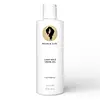What's inside
What's inside
 Key Ingredients
Key Ingredients

 Benefits
Benefits

 Concerns
Concerns

 Ingredients Side-by-side
Ingredients Side-by-side

Water
Skin ConditioningVp/Va Copolymer
Glycerin
HumectantHydrolyzed Jojoba Esters
Skin ConditioningJojoba Esters
EmollientCocoyl Hydrolyzed Quinoa Protein
Hydrolyzed Oat Protein
Skin ConditioningAloe Barbadensis Leaf Extract
EmollientPanax Ginseng Root Extract
EmollientSalvia Officinalis Extract
AntimicrobialNigella Sativa Seed Oil
EmollientBoswellia Carterii Oil
MaskingAminomethyl Propanol
BufferingCarbomer
Emulsion StabilisingSodium Phytate
Caprylyl Glycol
EmollientHexylene Glycol
EmulsifyingPhenoxyethanol
PreservativeCitric Acid
BufferingParfum 100%
MaskingWater, Vp/Va Copolymer, Glycerin, Hydrolyzed Jojoba Esters, Jojoba Esters, Cocoyl Hydrolyzed Quinoa Protein, Hydrolyzed Oat Protein, Aloe Barbadensis Leaf Extract, Panax Ginseng Root Extract, Salvia Officinalis Extract, Nigella Sativa Seed Oil, Boswellia Carterii Oil, Aminomethyl Propanol, Carbomer, Sodium Phytate, Caprylyl Glycol, Hexylene Glycol, Phenoxyethanol, Citric Acid, Parfum 100%
Water
Skin ConditioningCetearyl Alcohol
EmollientSimmondsia Chinensis Seed Oil
EmollientEthylhexyl Palmitate
EmollientOlea Europaea Fruit Oil
MaskingGlyceryl Stearate
EmollientAstrocaryum Murumuru Seed Butter
EmollientArgania Spinosa Kernel Oil
EmollientButyrospermum Parkii Butter
Skin ConditioningPersea Gratissima Oil
Skin ConditioningRosa Centifolia Flower Oil
MaskingCitrus Aurantium Amara Peel Oil
Skin ConditioningTocopheryl Acetate
AntioxidantBehentrimonium Methosulfate
Cetrimonium Chloride
AntimicrobialBiotin
AntiseborrhoeicNigella Sativa Seed Oil
EmollientTrigonella Foenum-Graecum Seed Extract
PerfumingPhenoxyethanol
PreservativeEthylhexylglycerin
Skin ConditioningParfum
MaskingWater, Cetearyl Alcohol, Simmondsia Chinensis Seed Oil, Ethylhexyl Palmitate, Olea Europaea Fruit Oil, Glyceryl Stearate, Astrocaryum Murumuru Seed Butter, Argania Spinosa Kernel Oil, Butyrospermum Parkii Butter, Persea Gratissima Oil, Rosa Centifolia Flower Oil, Citrus Aurantium Amara Peel Oil, Tocopheryl Acetate, Behentrimonium Methosulfate, Cetrimonium Chloride, Biotin, Nigella Sativa Seed Oil, Trigonella Foenum-Graecum Seed Extract, Phenoxyethanol, Ethylhexylglycerin, Parfum
Ingredients Explained
These ingredients are found in both products.
Ingredients higher up in an ingredient list are typically present in a larger amount.
Nigella Sativa Seed Oil is a fragrance and is an oil.
Parfum is a catch-all term for an ingredient or more that is used to give a scent to products.
Also called "fragrance", this ingredient can be a blend of hundreds of chemicals or plant oils. This means every product with "fragrance" or "parfum" in the ingredients list is a different mixture.
For instance, Habanolide is a proprietary trade name for a specific aroma chemical. When used as a fragrance ingredient in cosmetics, most aroma chemicals fall under the broad labeling category of “FRAGRANCE” or “PARFUM” according to EU and US regulations.
The term 'parfum' or 'fragrance' is not regulated in many countries. In many cases, it is up to the brand to define this term.
For instance, many brands choose to label themselves as "fragrance-free" because they are not using synthetic fragrances. However, their products may still contain ingredients such as essential oils that are considered a fragrance by INCI standards.
One example is Calendula flower extract. Calendula is an essential oil that still imparts a scent or 'fragrance'.
Depending on the blend, the ingredients in the mixture can cause allergies and sensitivities on the skin. Some ingredients that are known EU allergens include linalool and citronellol.
Parfum can also be used to mask or cover an unpleasant scent.
The bottom line is: not all fragrances/parfum/ingredients are created equally. If you are worried about fragrances, we recommend taking a closer look at an ingredient. And of course, we always recommend speaking with a professional.
Learn more about ParfumPhenoxyethanol is a preservative that has germicide, antimicrobial, and aromatic properties. Studies show that phenoxyethanol can prevent microbial growth. By itself, it has a scent that is similar to that of a rose.
It's often used in formulations along with Caprylyl Glycol to preserve the shelf life of products.
Water. It's the most common cosmetic ingredient of all. You'll usually see it at the top of ingredient lists, meaning that it makes up the largest part of the product.
So why is it so popular? Water most often acts as a solvent - this means that it helps dissolve other ingredients into the formulation.
You'll also recognize water as that liquid we all need to stay alive. If you see this, drink a glass of water. Stay hydrated!
Learn more about Water